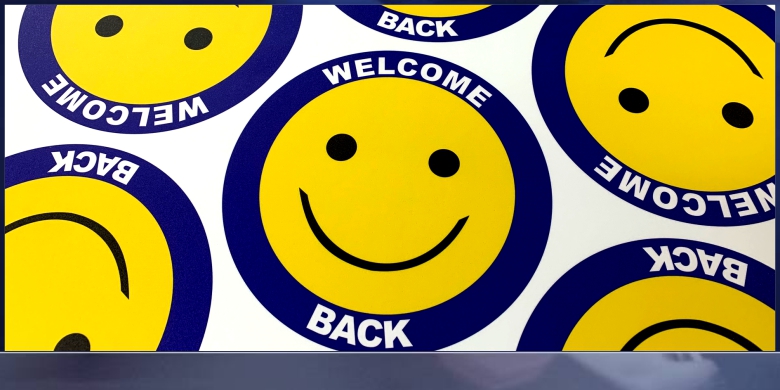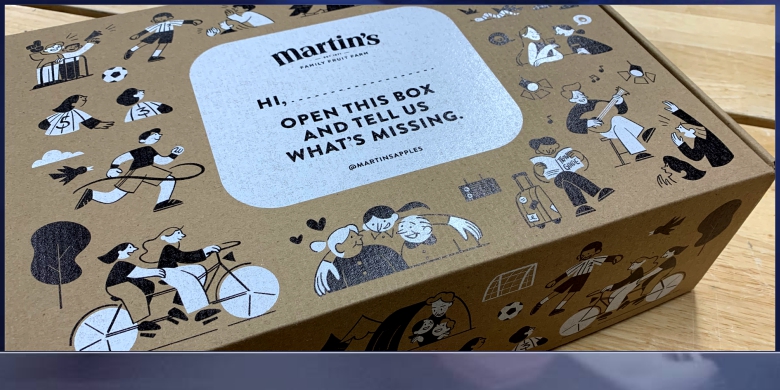Our Latest Blogs
Our Solutions News Blog was envisioned to gather and share information from the very best to help you and your business to become more effective.
Our Solutions News Blog was envisioned to gather and share information from the very best to help you and your business to become more effective.

Print and Direct Mail offers more ways than ever to remind people why they like you, need you and should keep paying attention to your business....
In the previous blog post we went into the 3 basics of any direct mail marketing process you may choose to create, including:
» Audiences to mail (beyond just demographics)
» How to draft your offer
» Designing for revenue
Today we give you the 4 key pieces that make up the reason people will take action from your mailing.
First, let's talk about the basics of effective imprint advertising and writing effective advertising: Headlines, Subheads and Image Captions.
The first critically important key is the development of effective Headlines. The headline is the most important component of any type of imprint advertising. It must work or nothing else matters.
Next in import are the Subheads, which are used to break up long blocks of copy.
Lastly are photo captions. Photo captions are marvelous opportunities to make persuasive arguments. People are drawn to pictures and often read the captions beneath the pictures before reading just about anything else.
The same basic guidelines applied to headlines, subheads, photo captions…
First, the headline should promise a positive benefit or ask a provocative question or both.
Second, it should telegraph its message in 12 words or less.
Third, it should stand alone, meaning it should make a complete statement by itself.
That's two thirds of the success formula: Headlines, subheads and photo captions are the critical ‘attention getting’ and ‘interest building’ components of imprint advertising, supported by good effective copy. The third part is the call to action in the form of a response device.
In person-to-person professional selling, one of the most common failings in salespeople is the fear of closing the sale, the reluctance to ask for the order.
Master sales trainer Zig Ziglar says that, “Asking for the order is what separates the poorly paid professional visitor from the Kingly Compensated Professional Sales Person.”
Just as closing the sale is a vital skill in face-to-face marketing, asking for the desired action clearly is a vital skill in advertising.
Incidentally, experience in effectively closing sales in person is a valuable asset in creating effective advertising. The same techniques, words, phrases and ideas used in personal selling can be used in print selling.
A strong direct call to action in direct mail is vital. Tell the reader exactly what you want them to do, how to do it, and when to do it. If response to your offer is in any way complicated, you may want to number the instructions; One, two, three.
The call to action may appear in several places in the typical direct mail package, such as the letter or in the main brochure.
And most importantly is the response device. A response device is the coupon to be redeemed, the order form or the reply card. Whatever your response device is, it should restate the basic offer and bonus and present the call to action.
These four keys are pivotal to generating a proper response from your direct marketing materials: Headline, Subheads, Picture Captions and the Call to Action.
- - - - - - - - - - - - - - - - - - - - - - - - - - - -
Please contact us for free information, tips and assistance!
Written By: Dan Kennedy / Souce: Magnetic Marketing
Canada Post gives you a powerful and effective sales force at a bargain price. Using the postman as your salesman via direct mail advertising is a great bargain. And one of the most effective marketing strategies available to most businesses, direct mail gives the marketer tremendous control over the sales process...
Properly used, direct mail and following direct mail principles can be one of the most effective and cost efficient marketing strategies you'll ever find for your business.
Here are the 3 basics of any direct mail marketing process you may choose to create:
People should also compile their own mailing list beyond just demographical outreach.
For one thing, you should maintain an up to date mailing list of all your customers and clients. Direct mail can stimulate additional business, introduce new products and services or promote sales or special offers.
--------------------------------------------------
For one thing, you should maintain an up to date mailing list of all your customers and clients. Direct mail can stimulate additional business, introduce new products and services or promote sales or special offers.
You can also build prospect lists of your own in many different ways. If people call your business for information, your staff should be trained to get the caller’s name, address, and email. If you exhibit at trade or consumer shows, you might use a free prize drawing or some similar method to obtain all the show attendees’ names and addresses.
You can also compile your own list from business directories, chamber of commerce directories, association directories, and other similar sources.
Success is found in repetition. You should think in terms of mailing offers and information to the same list 3-5 times during a 12 month period, not just once.
The list or list selection is the starting point of the direct mail marketing process. Then second comes the development of a matching offer.
The offer you make in a direct mail package needs to be carefully thought out and matched as closely as possible to the interests, needs and motivations of the list. And as a general rule of thumb, the more specifically matched the offer and list are the higher the response rate.
--------------------------------------------------
I want you to understand that it is not necessary or even advisable for you to engage the expensive services of graphic designers or ad agencies to create your direct mail pieces.
If you will make the format decision yourself, write the copy yourself and provide some graphic components yourself, then you have your piece prepared by printer that provide direct mail handling services.
An ad agency or graphic designer may charge you several hundred to a thousand dollars just to design a simple direct mail piece. Most small and medium sized businesses do not need to incur such costs.
You then have to write the copy that will present your offer and tell your story.
I've written all of my own advertising copies since the 1970s and have never had any formal education in advertising. I'm self-taught through studying the many excellent how-to books readily available, and through practice.
This is a very valuable skill and I urge most business people and entrepreneurs to develop the ability to write good advertising copy. There are two main reasons for this first. It's very costly to have your advertising materials written by a good professional copywriter or consultant. I charge between $3000 and $5,000, and my fees are typically lower than most other well qualified consultants in this field. Second, no matter how much you pay to get the very best outside help, no one can ever have the same feel for your business and your clientele that you do.
P.S. Don’t forget, whoever can spend the most money to acquire a customer wins.
- - - - - - - - - - - - - - - - - - - - - - - - - - - -
Please contact us for free information, tips and assistance!
Written By: Dan Kennedy / Souce: Magnetic Marketing
Make Your Business and Brand Stand Out as you Welcome Customers Back....

Welcome Them Back... with A Smile (Floor Grahics)

Welcome Them Back... Before You Open or Re-Open

Welcome Them Back... with New Directional Signage

Welcome Them Back... with A Cheer

Welcome Them Back... with New Packaging

Welcome Them Back... with A Surprise

Welcome Them Back... with A Walk In Special

Welcome Them Back... with Your Offer

Welcome Them Back... with Mailed Information
Please contact us for free information, tips and assistance!
There are three trends which we believe will be very important in the coming twelve months. Let’s have a look at each of these.
#1 Homeworking
It's not just big business, it's all sizes and types and it could be permanent. For example, major UK banks have mothballed 60% of their back office buildings. They haven’t been mothballed until the end of Coronavirus, they are permanently out of use. Homeworking has become essential for many and it not only raises challenges of connectivity, but also for adopting new systems that are accessible by your entire team 24/7 via the Internet.
To help address this with our Dominion Blue clients, we've significantly improved and enhanced our web-to-print products with customization options that match your individual specific needs. Doing more with less people and resources has become a key challenge for us all and we are here to help you.
#2 Complete solutions
Customers are looking for efficiencies and so the more complete your solution is the more likely they are to embrace your products and service. The same is true for us, with more and more new customers seeing the need for print and signage. We don't just stop there however, we work with your team to carefully review each idea. Once we are all clear on the end-goal, we can coordinate everything from the design and print thru to fulfilment. This can include professional installations involving signage and custom projects like real estate presentation centres, in-store wall decor, point of purchase displays and more.
#3 Continued change
What’s going to happen over the next few months. No-one knows! We are all in a situation where we have to adapt to changes that we cannot predict. It is a scary time.
With hundreds of years of accumulative experience our team can help you with your pivoting and adapting to this ever-changing social and business climate. You don't have to go it alone. find out more »
"Change is here to stay. Understanding the importance of resourceful thinking will allow you to be at the forefront of leading change."
Change in the workplace can create ripple effects throughout an organization. If you accept that leaders make decisions that are in the best interest of the organization, humans are imperfect, and outcomes can be challenging to foresee. Every human is vulnerable to what Daniel Goleman calls the “amygdala hijack.” When your fear takes over, it can affect your ability to make sound decisions. Sometimes your choices are not the best ones, and at times you don’t understand the impact until hindsight kicks in, and by then it’s often too late to turn back.
You may not be able to control external events; however, you do have the responsibility of leading you and making choices to promote positive change that aligns with organizational values.
Change is here to stay. Understanding the importance of resourceful thinking will allow you to be at the forefront of leading change. At times, change can be disruptive and overwhelming, and with the right attitude, a focus on business readiness, leaders can capitalize on change by learning to embrace change for what it is – possibility.
Leaders must consider the underlying intentions of the proposed change and keep in mind that sometimes uncomfortable change can bring desirable outcomes. For the future leader, change is the vital ingredient that must be welcomed and nurtured.
Here are 13 practical tips that office managers can implement to bypass the ego and graciously navigate change in the workplace:
#1 Manage Your State
To lead in this competitive world, one must accept change is inevitable. When you take responsibility for your state, despite your challenges, you show up to face the situation with a smile, and you leverage your strengths to enjoy the new experience. One way may be to embrace the opportunity by writing down responses to critical questions:
By asking these questions, you identify the importance and build the confidence to accept it.
#2 Success Leaves Clues
When dealing with change, often it’s the unknown that is scary. One way to break through the resistance is to imagine all the different possible outcomes and identify the best- and worst-case scenario. Ask yourself, “what’s the worst that can happen? Another strategy may be to connect with the last time you experienced a significant change and how you achieved the results you wanted. Identify the strategies you adopted and replicate.
#3 Focus On What Can You Control
It is essential to identify how much control over the situation you have. By putting things into perspective, you can identify the small things you can do to make the process easier.
If the change is beyond your control, adopt a reflective approach. Accept that there are things beyond your control and choosing to be uncomfortable will bring greater peace than waging a no-win war. Change is an opportunity to learn and grow rather than a setback.
Focus on what will produce results for you. Ask questions such as:
Focus on what you can influence to take the right action.
#4 Stay Grounded in Reality
Change is about being flexible. When the opposite occurs, you diminish your chances of being able to survive the transition. Your default thinking patterns will be out of alignment with the new environment, potentially leaving you behind. When you shift your thinking to a growth mindset, you identify that you may need to learn new skills, integrate new processes, or redirect resources. It is an opportunity for the business to become more efficient, effective, and productive. Identify a plan to respond to the change for you and by engaging the team, build a team plan in alignment with organizational change.
#5 Opt-out Of the Perpetual Negativity to Lead The Change
Sometimes talking a lot about your fears, anger, and frustration can be the worst advice. Harvard Business Review research highlighted that consistently espousing negative emotions hinders your natural adaptation process. That’s not to say ignore your feelings or bury them so they can pop up when you least expect it. Instead acknowledge your sense of anxiety, frustration, or anger and identify how it is influencing your thinking and disrupting your relationships. Look for the facts as everything else around the situation is a story you have created. Edit your story, look for practical steps that you can implement, and by doing so, you shift your focus from being problem-saturated to solution and future-focused.
#6 Remember What Victor Frankl Taught Us
Victor Frankl’s famous book, Man’s Search for Meaning, tells the story of how he survived the Holocaust by finding meaning in the experience which gave him the will to rise above it. He had returned home from years in Nazi death camps to discover his loved ones had all passed. Despite the tragic events, he recognized that he could not go back to the life he once had. He was free to find new ways to live, new opportunities to grow and build new relationships to share. Frankl’s story is an extreme example but a great reminder that even though you are never free from change, you do have the freedom to decide how you respond and what to do next.
#7 Lighten the Mood
Finding humor in situations can be a positive way to create light-heartedness to a problem. Rod A. Martin, a humor researcher, discovered that witty banter could lighten the mood and improve social interactions if the conversations are inclusive and respectful. Sometimes, sharing your struggles can be gold and reminding people that you are human.
#8 Look for The Silver Lining
Workplace change is a platform for a fresh start. Rather than getting caught up in the day-to-day things, invest time into the future you want to create within the workplace. Work out what you want to achieve, identify steps that will take you closer to your vision, break tasks down into smaller chunks, and identify timelines. Make sure to celebrate milestones as momentum generates motivation. When you look for the silver lining, you can use it to reinvent your professional persona and add new skills to your repertoire.
#9 Prioritize Data Over Complaints
Presenting an alternative idea if something isn’t working is the best way to lead the current course of things in a new and better direction. Another option may be to illustrate what works and what doesn’t by benchmarking. For instance, if a new program is introduced that you believe less effective than a previous one, compare results, prepare data, and plan a conversation. Data is a great way to shift an outcome in a different direction potentially.
#10 The Workplace Change Curve
Learning more about how workplace change works, organizations often refer to The Change Curve as a trusted and reliable tool. This model explains the transition process and emotions associated with change. It has been used to help people understand their emotional reactions to significant change. It provides a visual to predict how anyone in the process of workplace change is affected. The curve offers insight into how you know where you are on the curve and why and how other people experience similar emotions during transition.
#11 Water Cooler Conversations
If you want to stain the fabric of an organization, invest your energy into gossiping, whining, and closed-door conversations. When people don’t express their concerns in a resourceful manner, the impact creates ripples within the organization. Instead, leaders must lead by example, encourage teams to share concerns directly with them, and inspire colleagues to involve everyone in a decision that will impact everyone.
#12 Don't Let Communication Be An Afterthought
Communication must be a core component of the steps moving towards future actions. By creating an environment where all levels are on the same page, allows any communication gap to be identified and provides a space to mitigate rumors and speculation. Emotional drama permeates, and the fabric of the organization is stained. When leaders create spaces for employees to communicate their fears effectively, their concerns can be better addressed and alleviated. Empathy is the most excellent communication tool for leaders.
#13 Trust Your Instincts
Trusting yourself is vital once you have eliminated bias. If a decision is made within the organization that you feel is not in alignment with your values, then you must decide whether you want to continue being part of the organization in the future. Staying and hating is not an option. The more important question is, “what is your plan to buy-in to the change?” With the right attitude and actions, you will always find opportunities in the workplace change.
Source: Eden Blog / Written By: Angela Kambouris
"Every company’s biggest problem is communication,” says Scott McGohan." Read on to discover some solutions.
“It really doesn't matter how many times you do it,” says Scott. “If you do any of it, then you have a problem. If you do a lot of it, it's still going to be the number one problem.”
It’s a lesson he learned at an early age from his father, Pat McGohan, who started the business more than 45 years ago. “Growing up in the business and hearing from my father that the number one problem every business has is communication, I believed it,” says Scott. Over the years, he also saw it first-hand.
Here are 4 key ways to become more conscious and mindful about effective workplace communication.
1. Let employees do it on their time
Scott learned the most powerful way to communicate is to deliver content in a way that employees can consume it on their own time. “From a leadership standpoint, it's understanding that we have to recognize that our people aren't available to learn from us on our time. We have to figure out how to do that on their time,” he says.
Envision different channels you can use to deliver stories to employees in a way they will embrace.
For example, McGohan Brabender has a podcast they create in-house and they have a YouTube Channel. McGohan Brabender has learned that the podcasts are popular with employees since they can listen to it on-demand, whenever they have time.
“Some people like to see things, some people like to hear things, some people like to touch things,” says Scott. As a leader, your vision is to get people to feel things.
Right now, Scott focuses on trying to be short, simple, and sweet with content. “We’re embracing the fact that a lot of people today want to learn via their eyes and ears, in probably less than two minute snips. Any longer than that, we lose people's attention.”
2. Stick with it
McGohan Brabender has monthly meetings with all employees. “We look at: Where did we win? Where did we lose? Where are we at? How are we performing?” says Scott. It’s a meeting that encourages transparency and connection between employees.
They also have quarterly employee luncheons. “We'll invite the whole company in, and we'll have lunch. They can bring their kids, they can bring guests, and we've even had parents there.” Over lunch, they also talk about how the organization is doing, how they are performing, and where there is opportunity.
Another way Scott feels the pulse of the organization is through a weekly blog. He’s published the internal blog for more than 5 years.
Whatever a leader decides to do in terms of communication, the most important part is consistency. “If you say to your employees you are going to write a weekly blog, you have to it every week. You can’t miss. Our blog is five years in the running and it shoots out every week,” explains Scott. “Be consistent and be on time.”
3. Use affirmations
“Affirmation is probably the one thing that everybody desires,” says Scott. Scott’s learned to be intentional about how he uses affirmations to his people. In doing so, he’s able to energize and inspire his people.
“ As a leader, when you're telling stories about people in your organization, it affirms the great work they are doing. The magic happens when it inspires other people to want to be a part of a story,” says Scott.
“They hear what others are doing, and they want to be a part of that story. They want to have a chapter written about them. There’s magic in that—that’s what storytelling does.”
4. Show vulnerability
As a leader, have the kind of self-awareness that allows you to show vulnerability through your communication.
“Some may think if you are vulnerable, you’re looked upon as weak,” says Scott. “Vulnerability is a sign of strength. It lets people know they are not alone.”
Find a channel or format of communication that allows you to authentically open up with your people. “For example, for a lot of people, there's an uncanny way for people to be vulnerable in writing versus face-to-face with people. It is an opportunity for leaders to talk about areas in their life where they're vulnerable, or maybe where they're afraid,” says Scott.
“And it lets other people know that you might just be human. You might be just like them.”
When you get vulnerable, your people will respond with trust and openness, too. The result is a culture where employees experiment, take risks, and drive innovation.
Source: Forbes / Written By: Aileron
At Dominion Blue, our story started in 1912 with an ad featured in the city directory. It was one of eight companies involved in blueprints. We were located in the Bank of Hamilton Building at 432 Hamilton Street. Our focus was simple, offer what architects, engineers, contractors, the government and businesses wanted; preeminent quality large format Maps, Blueprints, Brown Line, and Blue Line Prints.
It was not a splashy opening, but it was honest. Our "can-do," "just-works" and our clients soon realized that we were ultimately providing print solutions that helped them to succeed. By hearing our story and knowing why we do what we do, they quickly discovered that we understood their needs.
A lot has changed since then. Of course, our state-of-the-art digital printing equipment and the breadth of our product and services offer is immense in comparison. But one thing has not changed; we've been building trust with our clients ever since that day and won't stop until we either meet or exceed each one’s expectations.
Knowing how to tell your business story needs to be a crucial part of your operations. A brand story has a strategic purpose aimed towards drawing people in. To perfect your story, try the following tips, and when you're ready give us a call because print can help bring it alive in many ways.
To perfect your story, try the following tips:
#1: Set The Parameters
Your business story should be engaging. But if it doesn’t have a clear focus, you’ll quickly lose the attention of consumers. Establish context right off the bat.
To start your brand story, answer the following questions:
Parameters will help you develop an engaging story that makes sense to your audience. Set the scene so that consumers know exactly what you’re talking about. Most importantly, establish why you’re telling them this story. This will guide the audience through the narrative and hook them all the way to the end.
#2: Be Authentic
Authentic storytelling is key to gaining consumer trust. Don’t try to fool your audience with an over-the-top tale. Customers know when you try to pull a fast one on them, and they don’t appreciate it.
Your business’s story doesn’t need to be elaborate. In fact, if your business doesn’t have an earth-shattering history, your story shouldn’t try to create one. A genuine narrative is more likely to connect with consumers than one without a shred of truth.
Transparency celebrates your uniqueness and acknowledges the human aspect of your brand. Recognize that things are not always easy by showing your own challenges and failures. This creates an emotional connection, as well as reveals admiral characteristics, like innovation and resilience.
You might want to take an “open book” approach to communicating with customers. Explain how things are made/done at your business. For example, you might use all local ingredients at your restaurant. Use these details to create an interesting story.
#3: Have A Clear Outcome
A great business story leaves your audience with something. What lesson was learned in the story, and what should consumers learn from hearing it?
Business stories should have a clear outcome. Provide a hopeful, thought-provoking message with actionable points that compel your audience to connect with your brand.
Here’s another story for you: In the late eighties, my partner and I wanted to write software, but we were not sure about the niche we should pursue. After doing tons of research in the phonebook and at the library (there was no internet back then), we learned that employment agencies had a desperate need for a recruiting network solution. Over thirty years after launching our startup, Top Echelon’s recruiting network has hundreds of recruiting firms and millions of candidates, which helps hiring professionals make more placements.
The story gives an idea of who we are and where we come from. The outcome sparks confidence in our offerings and values. You can use your business’s real-life outcomes to convey a message to your customers.
#4: Be Consistent
A disorganized brand story leaves customers confused and uninterested. Make sure your brand is consistent across all communication channels. Use the same colors, logo, and slogan for digital and print marketing materials. The repetition of images and verbiage associated with your business creates brand awareness.
You need to be consistent when speaking about your brand. Business storytelling takes practice. Know the story inside and out before presenting it to customers. This will help you tell the story naturally.
#5: Get Customers Involved
Use business storytelling to strike an emotional connection with customers. Talk about how an event related to your business affected you and what you learned. This creates an immediate response that makes your story memorable and shareable.
People like to be a part of stories. Your customers can be characters in your brand. Come up with ways to get your audience involved.
For example, Patriot Software reached out to some of our customers to hear their startup stories. Black Sheep Boutique and Lamplighter Brewing Co. were among several companies featured in business storytelling examples on our blog. Showcasing these businesses directly linked our customers to a part of our story.
Telling the story of your brand is an ongoing process. Each day, your business grows, shifts, and adds new chapters to its story. Make business storytelling an essential part of your operations to attract and retain customers.
Source: Forbes / Written By: Mike Kappel
Marketing often gets thrown on the back burner because it feels like time away from your business.
You’re happiest when you’re talking to your audience directly.
You’re telling them all about a product, service, or cause that you care about — and there’s a level of connection there that marketing can’t touch.
Or so you think.
It’s true — there’s plenty of yawn-inducing marketing material out there that makes you wonder if the writer herself was asleep at the keyboard.
But your business can do better than that. You can share something with your audience that awakens their attention, evokes emotion, and fosters ironclad loyalty..
Can storytelling really do all that?
Stories are the seeds of connection. They have staying power — think back to all the stories you can still remember from your early childhood.
And they’re more important than ever as a way to stand out from your competition.
Here are a few things storytelling can do for your business:
How can you start incorporating storytelling in your business?
Once you start to see the benefits of storytelling for your business, you’ll start wondering how you can start using it right away.
Luckily, you have plenty of outlets at your disposal. Your website, your signage, brochures, and printed communications, email and direct mail, your blog, social channels, presentation centres, and so much more.
When you're ready to start planning it all out give us a call and through our Print with Insight Program you'll be turning heads your way in no time.
Source: Constant Contact / Written By: Miranda Paquet
Last year was all about taking risks in graphic design. But most of the graphic design trends we predicted last year have become mainstream. Like incorporating a whole new world of colour, and breathing life into print with a rainbow of metallic huges. Click HERE to download the metallic ink design guide.
What are the BIGGEST graphic design trends of 2019 that you should be following?
That’s what this design guide will tell you. For an in-depth guide to the biggest graphic design trends in 2019, check out the full article and infographic HERE.
The blog post contains a ton of examples for each trend, as well as templates that you can use to stay on top of the trends. In the video above, we introduce you to the 8 graphic design trends that we predict are going to take over in 2019. We’ve included examples from some of the biggest brands in tech right now, including Apple, Spotify, MailChimp, Facebook and more.
If you want your branding to be ahead of the curve, try incorporating some of these graphic design trends into your proposals, marketing materials, packaging and internal communications.
Source: Venngage / Written By: Ryan McCready
In a survey conducted by ResearchNow for Adobe, 76 percent of marketers believe marketing has changed more in the last two years than in the previous 50....
Convenience Is the New Currency
Time and money have always been directly correlated, and for the last several years, consumers have been short on both. Even though we’ve made quite a comeback from the dark days of the economic collapse in late 2008, the Great Recession is still fresh on everyone’s mind.
As a reaction to the substandard economy that wrapped up the first decade of the new millennium, buyers have become obsessed with finding unsurpassed value, with competitive sellers bending over backward to come up with new ways to draw in potential customers. Bottom-line pricing, impeccable service, and personalized experiences have all become crucial to staying competitive in the post-recession marketplace, but another customer demand has risen through the ranks, forcing companies to rethink the way they market their products and services.
That demand can be summed up in a single word: CONVENIENCE
Click HERE to Read the Full Article »
Source: Adobe Digital Marketing
Everything Starts With An Idea
Here's a twist on Creativity and The Big Idea. Nothing is original, says Kirby Ferguson, creator of Everything is a Remix. From Bob Dylan to Steve Jobs, he says our most celebrated creators borrow, steal and transform. And how does copyright come into play. Embrace the remix.
Source: TED / Presenter: Kirby Ferguson
One Small Adjustment
What can you learn about perception from a social psychologist and body language expert? If you’re one of the 16 million people who have already watched Cuddy’s compelling TED talk -- you know there’s plenty to learn. Cuddy discuses how body language and even physical posture can affect not only others' perception of you, but your own self-perception as well. Could changing your posture change your life? It just might. Watch Cuddy’s TED talk and decide for yourself if an adjustment could alter your course.
Source: TED / Presenter: Amy Cuddy
“I feel stuck. Where should I go from here?”

It’s not uncommon to feel like there’s no obvious next step in your career. It’s hard work to guide yourself, especially when you’re walking into the unknown.
So what do you do when you feel stuck? Do you jump ship? Apply for a new role within your company? Or just stick it out? In the right context, any of those options could work out just fine. But how do you know which direction is right for you?
If you’re in marketing or a part of a big team, chances are you work with individuals with many different skill sets. Maybe you sit next to a woman named Tracie who’s a jane of all trades. It seems like there’s nothing she can’t do! Your other co-worker, Seth, might be the go-to-guy for all things analytics and reports. Sometimes he even holds team workshops on metrics and reporting tools.
Despite their differences, both Tracie and Seth are most likely equally valued by the company. Their roles represent two common directions an employee might pursue in one’s career, depth and breadth, and both are excellent paths to get yourself unstuck.
Click HERE » to View the Full Article
Source: Hubspot / Written By: Rebecca Corliss
When was the last time YOU listened carefully, reflectively, meaningfully and thoughtfully to a ''world-class", college commencement speech?
If your kids recently graduated, then probably recently - - BUT DID that commencement speaker's message REALLY hit home for YOU - - as well as your child? If YOU graduated from college or grad school a while back, do you even remember what YOUR commencement speaker had to say, share, his or her life-forging reflections, admonishments, hard-won lessons shared?
Each of the 7 speeches here is unique, wildly different than one another, each profound in its message. Each addressed the subject of how to embrace, manage/master or understand the rest of your adult life - - from highly-original vantage points and unexpected, deeply reflective "life-lesson processes" - - that might be relevant to YOU right now - - as YOU grapple with a tumultuous, and massively, changing world. There are a lot of BIG IDEAS left to think up and explore.